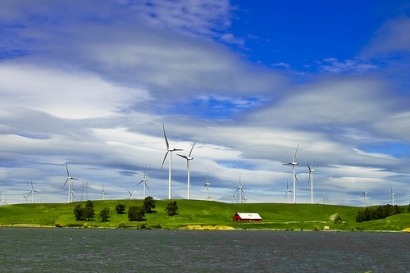
It also presents a novel method of assessing the resources needed to balance supply and demand in power systems with large shares of ‘variable’ renewables, such as solar photovoltaic, wind and tidal energy.
Wind and solar energy have been growing at double-digit rates for at least five years – a trend that must continue if a more secure, diverse and sustainable energy mix is to be achieved.
The World Energy Outlook from the Brussels-based organization, for example, foresees that 45 percent of global electricity supply will need to come from renewable sources by 2035 if the level of carbon dioxide in the atmosphere is to be limited to 450 parts per million – roughly consistent with a global temperature rise of no more than 2 degrees C.
Under this scenario, around 17 percent of electricity would need to come from variable renewables, up from 1 percent in 2008.
But this raises a host of important challenges, particularly because of the uncertainties that are inherent in variable electricity supply, the IEA acknowledges.
Among the questions that need to be answered are: How can such large shares of variable electricity best be integrated without jeopardising the stability of existing power systems? What is the maximum share of electricity that can come from variable sources?
The answers depend on the flexibility of the power system in question, the organization says.
The new book provides a tool to assess this flexibility, and in the process serves to reassure policy makers that the challenges of integrating large shares of variable renewables in power systems are far from insurmountable.
Assessing flexible resources
“Harnessing Variable Renewables: a Guide to the Balancing Challenge” lays out a four-step method for assessing existing flexible resources, which can then be used to balance increasingly variable supply and demand:
The book features eight case studies in which the FAST Method is applied to eight geographic areas with very different characteristics. The resulting analysis shows that each region has the technical resources to balance large shares of variable renewable energy.
Potentials range from 19 percent in the least flexible area assessed (Japan) to 63 percent in the most flexible area (Denmark).
The IEA also assessed the resources of the British Isles (Great Britain and Ireland together), 31 percent; the Iberian Peninsula (Spain and Portugal together), 27 percent; Mexico, 29 percent; the Nordic Power Market (Denmark, Finland, Norway and Sweden), 48 percent; the Western Interconnection of the United States, 45 percent; and the area operated by the New Brunswick System Operator in Eastern Canada, 37 percent.
This range of results is due to the different flexible resources found in these areas. Norway, for example, has extensive hydropower, which is a very flexible resource; while Japan’s power plants, many of which run on nuclear and coal, are not as flexible (it takes longer for these sources to respond to fluctuations in demand).
“While some areas are clearly more flexible than others, all power areas assessed show that greater technical potential for balancing variable renewable energy output exists than is commonly supposed,” said Richard Jones, the IEA Deputy Executive Director. He launched the book at EREC 2011, Europe’s Renewable Energy Policy Conferenceon 24 May in Brussels.
“The results from these case studies demonstrate that variability needs not be an impediment to deployment,” Jones said. “As long as power systems and markets are properly configured so they can get the best use of their flexible resources, large shares of variable renewables are entirely feasible from the balancing perspective.”
For additional information:

